
Topics
Guests
- Hebe de BonafiniHebe de Bonafini is one of the founders of the Association of the Mothers of the Plaza de Mayo, an organization of mothers whose children were “disappeared” during the military dictatorship in Argentina.
Former Argentine dictator Jorge Videla was sentenced to life in prison earlier this week. The 85-year-old former army general ruled Argentina during the “dirty wars” of the ’70s and ’80s.
Hebe de Bonafini is one of the founders of the Association of the Mothers of the Plaza de Mayo, an organization of mothers whose children were “disappeared” during this period.
Amy Goodman had the chance to speak with her in Buenos Aires last November. Democracy Now! was in Argentina for the 10th World Association of Community Radio Broadcasters conference, an annual meeting of hundreds of community radio stations from around the world.
Thanks to Andrés Conteris for translating this interview.
AMY GOODMAN: Can you start of by saying your name, the organization you’re with, and what it is you’re trying to do here in Argentina.
HEBE DE BONAFINI: [translated] My name is Hebe. I’m president of Mothers. What we’re doing in Argentina, apart from the trials that our lawyers are following, is to construct the country that our children dreamed of, for which we are working to construct housing and schools and make the marginal communities habitable, giving work to those who have been excluded — two or three generations who never worked, who lived in cartons or they lived from theft. We go to the villages, and we train them, and they themselves make their own housing. But they also have the obligation of training themselves and to finish their primary and secondary education. We do feeding places where we feed the hungry, and we do training for building housing, as well as health clinics and hospitals. The places where they lived that were trash bins — and we constructed dignified housing, more dignified and more nice houses than the one I live in, and they used to live in dumps, and we give them the houses fully furnished.
AMY GOODMAN: Can you tell us about your own personal story, how you founded the — well, the Mothers of the Plaza de Mayo?
HEBE DE BONAFINI: [translated] We usually don’t tell our personal specific story, because it would be very unjust that I tell my story because I wanted to talk a little bit more and that the other mothers weren’t able to tell their stories. But they are very similar stories. Some of us missing one or two or three children; me, I’m missing three. One was kidnapped in the street, another in their home, and another in a meeting of a union. Those were the places, as well as at the universities, the primary key places where they did kidnappings.
AMY GOODMAN: Were they sons or daughters?
HEBE DE BONAFINI: [translated] Two sons, one daughter. And one wife of one of my sons, who is like a daughter to me because she lived in my home. It was a year-and-a-half-long period that they took the three of them.
AMY GOODMAN: 1977?
HEBE DE BONAFINI: [translated] 1977, ’77, two, and in ’78 in the soccer World Cup tournament, they took another, 1978. Since the first moment that they took my first son, I have not stopped. At that time, the organization of Las Madres did not exist, and we went into the streets looking for them. We were founded as the Mothers on the 30th of April in 1977. And since that moment and since that day, not a single day has passed that we have [not] gone to the Plaza.
AMY GOODMAN: And did you ever find more information about your sons and daughter and daughter-in-law?
HEBE DE BONAFINI: [translated] Some of us Mothers had information from those who left the concentration camps, and because some of us were more insistent in our search. And we spoke with those who left the concentration camps. They would come out saying, “Yeah, there is one person there, and that person now lives — who left the camp, and now lives in the city of Ensenada,” so we would go there looking. And so, we follow every single lead that can lead us to any person who had been terrorized. They would often leave even more terrorized from the concentration camps and didn’t even want to talk.
And so, then I knew that my oldest son was first taken to the comisaría, the police station clinica. I knew right away that he was tortured for 20 days straight, almost to death. I learned this from someone who left that police station. I tried to go to the comisaría, the police station, and I entered in there screaming that my son was there. And they beat me up there, and they threw me onto the street.
AMY GOODMAN: What was your son’s name?
HEBE DE BONAFINI: [translated] Jorge. My son was taken to several different concentration camps, as was their usual practice. My youngest son, they took him to a large concentration camp, which is called La Cacha.
AMY GOODMAN: What was his name?
HEBE DE BONAFINI: [translated] Raúl. And it’s called La Cachavacha, the place, and Raúl was among many children in that place. He was taken from a union meeting, where there were lots of people at that meeting at the time. And to the wife of my oldest son, they took her from a candy store.
AMY GOODMAN: What was her name?
HEBE DE BONAFINI: [translated] María Elena. So they took her to the concentration camp called Puente Doce, the 12th Bridge. And it’s near the town of Ezeiza. She was a very beautiful, very pretty young woman. And they made her feed food to the disappeared who were there. So they did this in order to create differences. She denied making food, preparing food, and they shot her on the spot. They fired.
AMY GOODMAN: She refused to make food?
HEBE DE BONAFINI: [translated] She refused to make food, and therefore she was killed. To all of the children, all of the young people who were in La Cacha, they allowed them to die of hunger. They did not take them more food or water, and they died there. So, no one could tell about that place, because there were no witnesses who ever left alive.
So, some of the concentration camps have a lot of judicial proceedings because there were witnesses who left there, like La ESMA, many witnesses who left La ESMA. But the other places don’t have witnesses, because they were all liquidated.
So, three of the Mothers were also kidnapped, really the three who knew the most. At the end of 1977 was the first kidnapping of one of them, of the Mothers.
AMY GOODMAN: Of the Mothers who marched in the Plaza de Mayo.
HEBE DE BONAFINI: [translated] Yes. Azucena, Maria and Esther are the three women, Mothers. Azucena Villaflor, from the Peronist movement, she was very, very active. Maria Ponce worked with the Church of the Third World. And Esther was a biochemist and very active, and she was Paraguayan and left the dictatorship of Stroessner in Paraguay. Kidnapped between the 8th and the 10th of December in 1977, when at that time the Mothers’ movement grew to be 200.
And so, we were forced to begin from the beginning. No one wanted to return to the Plaza. So two or three of us went around to the homes of the Mothers and said, “Now we have the sons and daughters disappeared, and now we have Mothers disappeared. And we have to do something, and we’re not going to succumb to the martyrdom.” Martyrdom, because they did everything to us. But we were able to organize the mother’s organization, and we have grown a great deal, because now we do everything, and we have grown a great deal.
Now we have a very radical position. The Mothers have socialized maternity, because it’s not all of the mothers from all of the children who have disappeared. And so, we thought it was unjust to only make demands for some of the mothers and not all. So we decided to ask for all. Our handkerchiefs that we wear do not have just the name of one of the children disappeared. And we also rejected everything that had to do with individual struggle. So we did not accept the economic reparation that was offered, because what has to be repaired with justice cannot be repaired with money. We did not accept he exhumation of cadavers, of corpses, because, in the first place, a revolutionary is never someone who has died or is in a bag with bones, and the other thing is that no one ever took responsibility for what happened and said “I’m the one who killed them.” So why should we accept it if they are not admitting it?
AMY GOODMAN: What gave you the strength to go on when other Mothers were kidnapped and disappeared?
HEBE DE BONAFINI: [translated] A great responsibility. So, we had begun this organization together, to work together, and our commitment was never to abandon the work for the children — first to try to find them alive, and then, later, to search for justice, and then to continue the path they were on, to do what they wanted to be done, for which they gave their lives.
AMY GOODMAN: Can you talk about the forensic project, the DNA project?
HEBE DE BONAFINI: [translated] No, we’re not involved with that, because that more belongs to the grandmothers than the mothers. The grandmothers don’t go to the Plaza. Their work is to find — they seek to find their grandchildren and the bones of their grandchildren and dead. But no, we don’t do that, from what I’ve already said. We already know that they’re not all going to appear. I never want to imagine my children as a pile of bones. They gave their life for something they wanted, which is huge, and so we cannot detain ourselves around burials, which is Western or Christian, or a drop of blood, around DNA. No, that’s not what we’re about.
AMY GOODMAN: Can you talk, Hebe, about the white kerchief that you wear?
HEBE DE BONAFINI: [translated] When all of the Mothers were united, there were 200 of us. There were 14 or so that began, but then we were over 200. In the middle of October of 1977, which is the day of the Virgin, here they do a public show, and they put forward a sanctuary. And young people go, many young people. So the Madres decided to go, even though at that time we didn’t know each other. All of us used our nicknames, which were Beba, Pipa, Chola — nicknames. We didn’t even know our own real names. So we then decided to identify ourselves with something very much in particular, in order to identify ourselves at nighttime, because it comes to be dark after we walk for 70 kilometers. “So, why don’t we put on a kerchief?” was the suggestion of one of the Mothers, because at that time they did not use disposable tissues. So the first kerchief was actually a handkerchief. Later, we put the name on the kerchief, and we then socialized it for all Mothers, and then we put everyone on it. And this is what identifies us in the world. And it is as if it were an embrace from our children. And it is a kerchief for life itself, not for death. We don’t want them to identify us with death. We only want life to identify us.
So we have this place called La ESMA, which is not a museum; it is a school for art. So we gave it a new name, which is called Ecune phon., which means a cultural space for our children. And now they are putting a gathering place for theater, which is marvelous. Senior citizens go there, children go there, everyone. There was a place of death, and we became life affirming and put life there. I told President Néstor Kirchner that we wanted the naval military school, we wanted that place. And that’s where they did the training for killing and torture. And now we do teaching for life and to make people happy in the very same place.
AMY GOODMAN: And what about the pictures you carried in the Plaza de Mayo?
HEBE DE BONAFINI: [translated] We no longer take those photos. Here, there is a photo that we — here’s a picture of all of the photos that we used to carry. We used to carry these photos, and we put them in a pyramid. We covered the pyramid in the Plaza de Mayo with these photos, without names, nameless photos. And now we take all of them to this cultural space, our children, and now we call it a gallery of the portraits of the revolutionary ones. Very, very impressive, and it’s a very strong symbol that they are there.
AMY GOODMAN: And why did you march in the Plaza de Mayo, that particular plaza?
HEBE DE BONAFINI: [translated] Because it is in front of the place where government is headed. And it’s a challenge to go there, because it was not permitted for us to go there. It’s like — it’s just the same as the White House. And it has always been a challenge.
AMY GOODMAN: Can you talk about, Hebe, the significance of these trials that are happening now?
HEBE DE BONAFINI: [translated] We are involved in the cases before the courts where we have proof, and these are judgments around concentration camps. We have a great team of lawyers, and they are working on these cases. But about 10 or eight years ago, we put forward the proposal about how is it that we want them to remember us, because now we, the Mothers, we’re getting older, our ages between 80 and 96. And so, we started to ask ourselves, how do we want to be remembered? As the Mothers who would chase the military so that we could try to get justice? Or, do we want to be remembered as women who could construct a new homeland, just as our children were fighting for? So, at this stage in life, what’s most important — to put a military man in prison or that a child have food and housing and maybe study and have healthcare and be happy?
We chose happiness for the children, and that’s why we created the mission which is called Shared Dreams. And this is the construction of housing with a new system that we have, and we build very beautiful homes. And this is to eradicate the emergency villages for the desperate poor. It’s so emotional to see people living in dumps, and then, three months later, men and women are working together, constructing new homes, then, in a new way, feeling like they are people once again and citizens of the country. We, in order to give them work, don’t even ask them how they made a living before. An opportunity just to work, it changes their lives. They leave drugs and alcohol behind, and it’s a transformation which is profound and marvelous.
AMY GOODMAN: For those people who say, “Why do you look back? Look forward. That was history.”
HEBE DE BONAFINI: [translated] You cannot construct a country if in fact you do not have a history. We do not look back and be paralyzed by that. It’s not a question of only memory. We refer to the fact that the memories have to be fertile and have to construct something. That’s why we decided to struggle forward, so that the people have what belongs to them. And we were able to do that because President Kirchner accepted our proposal for this contract, because money, we do not have. Perhaps we have some prestige because they respect us, because we’re not going to be involved in theft. And at the end of this year, we are going to reach 10,000 homes that have been built. It’s a great deal for us. It’s a huge amount.
AMY GOODMAN: Hebe, for those who — when you look back at the period before 1976, what are the signs, now, as you reflect, that you might not have taken seriously then, about where your country was headed?
HEBE DE BONAFINI: [translated] There were a great deal of deaths before ’76, because there was like a mafia. There was this anti-communist alliance that was killing people, even before ’76. And there were young people who were killed at that time. A great deal of persecution was still happening then. And our children that were militants were always in danger, but we did not know that it was going to be so serious, so grave. In no way we knew this. So I worked in my home, and they studied, and we were a normal family before ’76.
AMY GOODMAN: And were you telling your kids, “Why are you doing this?”
HEBE DE BONAFINI: [translated] I helped them at times, because sometimes we had to have some children stay at our home. But it was mostly a comfortable kind of being able to support, without risk. My son told me, “Come march with us in favor of those who are in prisons.” “No, I’m going to prepare the signs that you will take for the march,” because that was less of a commitment.
AMY GOODMAN: And do you remember the first day you stepped outside and you picked up one of those signs?
HEBE DE BONAFINI: [translated] I never went to any of the marches for the imprisoned until they took my own children. When they took my children, with a group of Mothers, we went to the Plaza and we took that sign, that famous sign for Videla. When the months passed and we started to grow, then the police came and said, “Leave.” And that’s exactly when we started to march.
AMY GOODMAN: What is the famous sign for Videla?
HEBE DE BONAFINI: [translated] It’s a letter sign. So it’s a letter that we wrote as Mothers, a very innocent letter that we wrote as parents asking for our children, and asking specifically where are our children?
AMY GOODMAN: Did Videla respond?
HEBE DE BONAFINI: [translated] No.
AMY GOODMAN: And what about the media at the time?
HEBE DE BONAFINI: [translated] At that time, the press media was in favor of the military, and so we, the Mothers, were dangerous. Every Thursday that we went to the Plaza for our vigil, they would arrest us every single time. And they would release us, and then we would go back every Thursday.
AMY GOODMAN: Did the media, like Clarín, like La Nación?
HEBE DE BONAFINI: [translated] Nothing would come out in these.
AMY GOODMAN: They wouldn’t report it?
HEBE DE BONAFINI: [translated] They would report as if nothing bad were happening in this country. The disappeared were an invention that came from Europe or from the groups that would create a poor image of our country. Only when the Mothers started to go out did our stories start to get out more. Something that when it came out in the press in a major way, it was because a North American journalist came. And this journalist, in a very hidden kind of a way, started to ask us questions. The police then saw that she was doing this and asked for her documents. And we told her, “Don’t give them your documents, because they won’t give them back.” So we, the Mothers, surrounded the policeman and insisted that the documents be returned. And he was a little roughed up, and he gave back the documents. And that story got out to the world that these Mothers in the Plaza de Mayo who were looking for their children defended this North American journalist in the Plaza.
AMY GOODMAN: Who were they? Or rather, who was he?
HEBE DE BONAFINI: [translated] She was a woman journalist who was there. And in the history of the Mothers, we have her name. I don’t remember her name. Very courageous woman.
Terence Todman came as a — was sent by the human rights community from the United States. And we wanted Terence Todman to see us. And we went at 11:00 in the morning to the Plaza de Mayo. And so, in order not to be a bad image for this human rights person who came from the United States, they sent a delegate from Videla’s government, from the house of government, and they said if we, the Mothers, left and went home, then they would receive him. So that created division with the Mothers, and some said, “No, let’s go, because then they’ll receive us.” Or, no, then others insisted, “No, we’re not going to go.” Some Mothers did in fact leave. Others of us stayed.
So then they sent a truck from the military, and they had their heavy weapons, and they came down from the truck. And they left the truck, and we told them, “Point and fire.” And that’s how the woman journalist was incredibly moved by our courage. She said, “How is it possible that you’re doing this?” And she wasn’t able to make the report in that moment, but it did go out that that’s what happened. So, the journalists who came and tried to follow this story, they were in fact quite persecuted. It was not easy. They didn’t want the story to get out at all.
AMY GOODMAN: What gave you the courage?
HEBE DE BONAFINI: [translated] Nothing. Everybody makes the same question to us. When you are going to have a child, you don’t think about yourself; you think that the child should be born well. You don’t think about yourself. You want to have your own child. That’s all. And it’s the same thing. It’s as if you are giving birth in a constant way. You can’t think of yourself.
AMY GOODMAN: What do you think your children, if they were here today, would say to you?
HEBE DE BONAFINI: [translated] They would call me mother, or the fat one. These were very kind ways that they called me, my nickname.
AMY GOODMAN: Were they all of your children?
HEBE DE BONAFINI: [translated] All of them are my children now. Now I have 30,000 children.
AMY GOODMAN: Thank you very much.

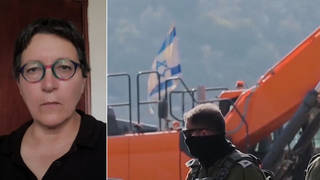
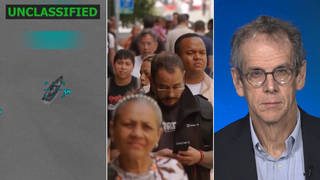
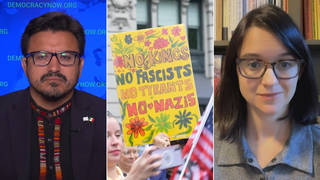
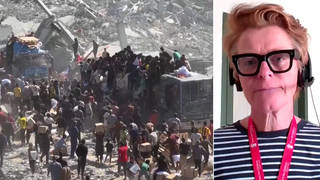





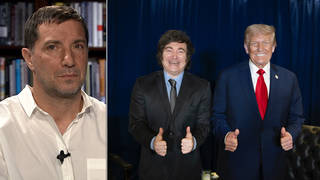
Media Options